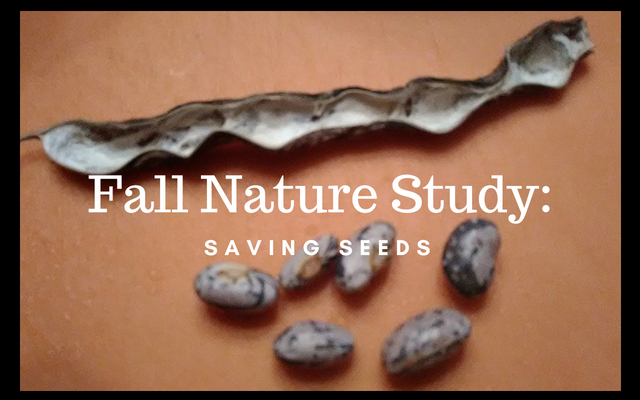Fall Nature Study: Saving Seeds


Each spring, my children and I start seeds for nature study. Eventually, we transplant them to the garden, care for the plants and harvest the fruit. A few years ago, we decided to allow the process to come full circle by learning how to save the seeds, as well. There are a few different ways to save seeds for your plants and it depends on the type of seed.
Bean plants are easy to save seed from. You simply leave some of the pods on the plant until the fall, when the skin of the bean is completely dry and papery. Then, you pick them, remove the beans from the skin, and label an envelope to save them in for planting in the spring.
Many other seeds can be saved by fermenting. The fermentation process can help control seed-borne diseases that could affect your future plants. We have saved tomatoes, peppers, eggplant, and pumpkins/squash this way. Make sure the fruit is completely ripe first. Remove some seeds, rinse any pulp off of them, and place them in a jar of water. Stir the seeds carefully with a spoon, once a day, for about three days. You will notice that some of the seeds float to the top and some sink to the bottom of the jar. The floaters are not viable and can be discarded at the end of the third day. Next, strain the contents of the jar, saving the seeds that sank to the bottom. I pour mine into a tea sock. Then, I spread them on a plate until they are completely dry, at which point I seal them in a labeled envelope.
You may want to write the year that you saved the seeds, along with the name of the plant, in case you do not plant all of them and have some left over the next year. I have successfully used seeds a couple of years after saving them, but they do decrease in viability with age. Another trick for keeping them is to place the envelopes of saved seeds in a container in the back of the refrigerator. The cold temperature keeps them fresh longer.
Interestingly, I found that the seeds that we planted this year, that had been saved from our own garden, actually grew much more robust plants than our store bought seeds. I am not sure if they were more acclimated to our particular soil, but I think it will make an interesting nature study experiment next spring, to compare our own seeds to the purchased ones, and chart their progress.
Another fun activity that my children did was to set up a stand in our front yard and sell packets of saved seeds, sort of like a lemonade stand.
There’s something really special about planting seeds that you’ve saved from your own plants. It gives children a visual of the way God provides for us and helps them to see the whole circle happening firsthand.
“Verily, verily, I say unto you, Except a corn of wheat fall into the ground and die, it abideth alone: but if it die, it bringeth forth much fruit.” John 12:24
Heather Eberlin is a married mother of four children, ranging in age from six to twenty-five. She is currently homeschooling her two youngest children and has felt called to share her journey in order to encourage others. She in an amateur gardener who is amazed at the things that God’s creation reveals when you take the time to pay attention to it. You can follow her Musings from My Garden.










































